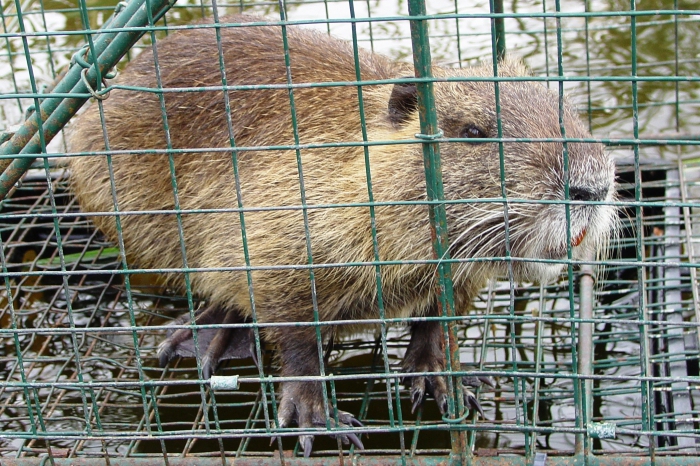Some people have the erroneous opinion that nutria is bred solely in order to get high-quality and inexpensive fur. But it is not so. The value of animals, in addition to the skin, also lies in dietary, tender and very tasty meat. For this reason, the cultivation of nutria at home is becoming increasingly popular. Due to the fecundity of these animals, it is possible to provide tasty and healthy meat not only to your family, but also to all relatives.
Nutria: breeds, breeding, keeping, care
Nutria (marsh beaver) refers to mammals from the order of rodents. This is a kind of unique animal. The lifestyle of the animals was reflected in a very interesting way on the structure of their organism. Ears are covered with dense fluffy hair so that water cannot get into them while swimming. In the nasal openings there are special muscles that cover them during diving. The lips of animals have an interesting structure: in front they are divided and converge only behind the teeth, which allows the animal to gnaw plants under water. Water does not get into the mouth.

The animal has 20 teeth (4 well-developed incisors and 16 molars). Their color is a kind of indicator of age and state of health: healthy animals have orange teeth (they become lighter with age), but those who have problems with their bodies are pale with black spots.
The tail of animals under water serves as a helm. Due to the semi-aquatic lifestyle, the glands that produce milk are located quite high - 4-5 pairs of nipples at a distance of 6-7 cm. This allows babies to suck the milk of the female when she is immersed shallow in water. Adults usually weigh up to 6-8 kg, in some cases reach 12 kg. Males most often percent 20% heavier. Nutria has a very good hearing - at the slightest rustle, the animals are alert. The rest of the senses are much less developed, but at night the vision improves. Nutria run fast enough (but at the same time they get tired quickly). The body temperature of rodents can vary between 36.5-38.5 ° C, and the respiratory rate per minute is 45-55 breaths.

An interesting fact is that during swimming, the heartbeat is reduced by 4-5 times, and the pulse drops per minute to 10-20 beats. The optimum temperature for nutria is 15-20 ° C. In extreme heat (up to +40 ° C), but in the shade and in the presence of water, rodents can also feel completely normal. But if there is a further increase in temperature and there is no water, animals can receive heat stroke, which, as a rule, ends with the death of a rodent.
In nature, this mammal is predominantly nocturnal. Nutria, the breeding and maintenance of which is carried out in cells, can be active during the day, however, the peak of their mobility is achieved in the evening and at night.
Nutria Breeds
There are many breeds of these animals, which are named mainly by the color of the fur coat. The main ones are:
- golden;
- white Azerbaijan;
- pastel;
- black
- White Italian
- smoky;
- snowy;
- cream;
- pearl;
- beige;
- mother of pearl;
- albino;
- lemon;
- silver;
- brown exotic;
- and etc.

But the optimal breed for breeding in household plots are standard nutria. They are characterized by higher fecundity and are not very demanding in care.
Optimum Nutriment Conditions
Nutria swim and dive remarkably, lead a semi-aquatic lifestyle in the natural environment, are most active at dusk and at night, build houses for themselves from the stems of marsh plants, which usually have several moves. On large farms they create special conditions that are most consistent with natural. If you are breeding nutria at home, this can not be done. It is only necessary to try so that the content of rodents corresponds to the parameters listed below.
List of conditions
The optimal conditions for breeding nutria are as follows:
- Despite the thick fur, sometimes exceeding a length of 8-10 cm, nutria tolerate cold, drafts and dampness rather poorly. The place that is reserved for their home should be warm and dry.
- The summer and winter contents of these animals are significantly different, so you should approach the issue of care and breeding of nutria very seriously.
- These animals are rodents, and this should not be forgotten when selecting cells. The less wooden parts there are, the more intact the cells themselves and their inhabitants will remain.

- The room where nutria will be kept should be fairly bright. In addition, it is necessary to carefully monitor that there is a minimum number of sharp objects in the cells.
- It is advisable to store feed in a separate, dry and clean room.
- Nutria can easily become infected with various infectious diseases, so you need to choose a place under the cells and pond quite carefully, trying to keep it as far away as possible from a dangerous source of infection.
- Nutrients urgently need a regular vet checkup. The quality of the meat and the beauty of the fur, for which many grow these animals, depend on how healthy the animals grow.
Content
The winter content of these rodents is significantly different from the summer, so anyone who decides to breed animals at home is recommended to study all the nuances in more detail.
Nutria: care and breeding in the winter
Animals love warmth, tolerate a slight cooling, but nothing more, because in the winter period all animals must be placed in well-insulated cages. It is better if they are located at a certain distance from the ground. If this is not possible, then cells with nutria can be placed on special wooden pallets and insulated with litter, which is recommended to use hay or straw.

Nutria, breeding and maintenance of which occurs in winter, in severe frosts, even in a warm and well-designed room can freeze, therefore they often burrow headlong into the litter. There is no need to worry about this, the animals are just very cold. The only thing that can be done for them is to add litter and increase the amount of feed. In addition, it is necessary to carefully ensure that the water does not freeze in the drinkers, it is better to heat a couple of buckets of liquid than to treat colds.
Frozen fruits and vegetables are also harmful to nutria, so you do not even need to try to give them to them. It will take a lot more money to treat animals than to buy more fresh food.
Summer content
In the summer, nutria can also be kept in cages by regularly cleaning and ventilating the room. But you can also select a separate piece of land for animals and enclose it with a net, dig a hole for water, put several boxes instead of houses and run rodents there. Such maintenance and breeding of nutria is considered semi-free, since they are still under constant control and are completely dependent on its owner. Feeding troughs are placed in the pen, where animals can freely satisfy their hunger.
It is also possible such a way of keeping animals, as the creation of such conditions in which they live in the wild. To do this, dig a large pond, then fill it with water and the seeds of various water plants. This is best done closer to the fall, as in the spring the seeds will begin to grow, and the lake will be covered with greenery, which the nutria love so much. When the pond is ready, animals can be released into it, which will settle there very quickly. If the artificial lake contains a sufficient amount of grass, rodents can practically not be fed, only occasionally add vitamins and animal feed. Animals can be at large until the colds, and with their onset, all should be caught and placed in cages.At this time, adult nutria is usually slaughtered, leaving only intended for breeding. Females with young animals can be placed in one cage.

This procedure is repeated with the onset of heat, which is very convenient, since it allows you not to spend extra time on the supply of water and feed, as well as on cleaning the cells and ventilating the room. In water, the nutria wool becomes thicker and more beautiful, animals gain weight well. The only negative of this content is that it is necessary to constantly monitor the quality of water and soil, because nutria are not used to living in swamps, and acidified soil can cause many dangerous diseases. The lake needs to be dug in solid non-clay soil and once a month to check its condition, periodically releasing dirty water and filling the reservoir with clean.
Feeding
Nutria is fed with compound feed, hay, corn stems, rhizomes, onions, grass, etc. In addition, they add vegetables to the diet: carrots, zucchini, cabbage, beets, and much more. Animals quickly get used to a certain regime, so you should adhere to a strict daily routine when feeding. Nutria enjoy eating porridge with vegetables. In summer, a bowl of clean water should always be in the cage, especially in pregnant females and in those without a pool.
Why are nutria popular with farmers?
Breeding nutria has the following advantages:
- These are very friendly animals that quickly get used to people. Nutria, breeding, maintenance, care for which are not at all complicated, despite their formidable appearance, respond to affection and never show aggression without good reason.
- Nutria does not require meat food: for full development and normal growth, grass, hay and root crops are enough for them.
- Breeding nutria does not require large funds and a separate heated room, and brings an annual, stable income to the family budget.
- Nutria are precocious animals. Their slaughter occurs at 14-16 months, and in certain cases at the age of six months.
- These animals are not susceptible to viral diseases and endowed with sufficiently stable immunity. Despite the fact that they are thermophilic animals, they can easily tolerate low temperatures (up to -20 degrees).

6. Nutria skins are in great demand not only in large garment factories, but also in small home workshops involved in leather dressing and sewing fur products.
7. Nutria provides farmers with a large amount of valuable dietary meat throughout the year.
8. Breeding these rodents allows you not only to earn money, but to sew fur coats, hats, mantles and mittens from quality and very warm material for the whole family for the winter.
So, home breeding of nutria is convenient, profitable and virtually waste-free, because after slaughtering animals, the farmer receives not only fresh meat, but also beautiful quality skins.








